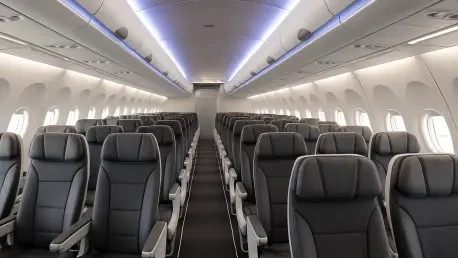In an era where airlines face intense pressure to balance passenger satisfaction with operational efficiency, Avianca, a key player under the Abra Group, has embarked on a transformative journey by integrating the Airbus A320neo with its innovative Airspace Cabin into its fleet. This move signals a bold step toward modernizing its narrow-body aircraft lineup, aiming to redefine travel standards across short- and medium-haul routes. The purpose of this review is to evaluate whether this strategic investment delivers on its promise of enhanced comfort, improved cost-effectiveness, and alignment with sustainability targets in a highly competitive aviation landscape.
The adoption of this advanced aircraft is not merely a fleet upgrade but a reflection of broader industry trends pushing for greener and more passenger-centric solutions. With over 25 countries and 80 destinations in its network, Avianca seeks to strengthen its market position by leveraging cutting-edge technology. This analysis delves into how the A320neo fits into the airline’s vision and whether it can meet the dual demands of customer expectations and environmental responsibility.
A critical aspect of this modernization is the Abra Group’s overarching plan to streamline operations across its portfolio, including Avianca and other carriers. The introduction of the A320neo represents a piece of a larger puzzle, with orders for numerous aircraft over the coming years from 2025 onward. This review aims to assess if such an ambitious rollout can truly transform the travel experience while addressing the challenges of integrating new technology into established systems.
Overview of the Airbus A320neo Airspace Cabin
The Airbus A320neo, equipped with the Airspace Cabin, stands out as a game-changer for narrow-body aircraft, specifically tailored for airlines like Avianca operating extensive regional networks. Designed for short- and medium-haul flights, this model incorporates state-of-the-art features that prioritize passenger convenience and operational agility. Its role within Avianca’s fleet is to serve as a backbone for connectivity across the Americas and parts of Europe, ensuring seamless travel for a diverse customer base.
Among the standout elements of the Airspace Cabin are the XL overhead bins, offering 60% more storage capacity for carry-on luggage, a feature that addresses a common pain point for travelers. Additionally, dynamic LED lighting adjusts throughout the flight to create a more relaxing ambiance, enhancing onboard comfort. These design choices reflect a deliberate focus on elevating the passenger experience, setting the aircraft apart from older models in the same category.
Avianca’s customization of the A320neo further distinguishes it, with exclusive Premium seating in a two-by-two layout crafted by Recaro. This configuration, unique to the region, targets passengers seeking added space and luxury on shorter routes. Combined with the aircraft’s modern aesthetics and functional innovations, these elements position the A320neo as a compelling option for airlines aiming to differentiate their service offerings in a crowded market.
Performance Evaluation of the A320neo Airspace Cabin
Assessing the real-world performance of the Airbus A320neo with the Airspace Cabin reveals a strong alignment with modern aviation demands, particularly for an airline like Avianca with a vast and varied route network. The cabin design significantly boosts passenger comfort through thoughtful features like spacious storage and ambient lighting, which reduce stress during boarding and in-flight phases. Feedback from initial operations suggests that travelers appreciate the enhanced environment, marking a notable improvement over previous fleet configurations.
From an operational standpoint, the A320neo delivers impressive fuel efficiency, a critical factor for airlines aiming to reduce costs amid fluctuating fuel prices. The aircraft’s advanced engines and aerodynamic enhancements contribute to substantial savings, allowing Avianca to optimize its bottom line while maintaining service frequency across key routes. This efficiency also translates into a lighter environmental footprint, with reduced emissions supporting the airline’s commitment to sustainability goals in line with global standards.
The aircraft’s integration into Avianca’s network demonstrates its adaptability to diverse operational needs, from high-density urban routes to less frequent regional connections. While early data indicates positive outcomes in terms of reliability and turnaround times, the long-term impact on fleet-wide performance remains under observation. Nonetheless, the A320neo’s ability to meet industry expectations for modern narrow-body aircraft positions it as a valuable asset for airlines navigating the complexities of growth and environmental stewardship.
Pros and Cons of the Airbus A320neo Airspace Cabin
The Airbus A320neo Airspace Cabin brings several advantages that make it an attractive choice for airlines focused on passenger satisfaction and operational gains. The increased storage capacity with XL bins addresses a frequent traveler complaint, while the tailored Premium seating offers a competitive edge in attracting higher-fare customers. Additionally, the fuel efficiency of the aircraft not only lowers operating costs but also aligns with sustainability initiatives, a growing priority in the aviation sector.
On the downside, integrating a new aircraft model into an existing fleet poses logistical challenges, including crew training and maintenance adjustments. The upfront investment cost for acquiring and customizing the A320neo can strain budgets, particularly for airlines managing large-scale fleet renewals under tight financial constraints. These hurdles require careful planning to ensure a smooth transition without disrupting service quality or operational flow.
Balancing these factors, the A320neo appears well-suited for carriers like Avianca that prioritize a modern travel experience and long-term cost savings. However, its success depends on the airline’s ability to manage integration challenges and leverage the aircraft’s strengths in targeted markets. For airlines with similar goals, the benefits of enhanced passenger appeal and environmental performance may outweigh the initial drawbacks, provided there is a robust strategy for implementation.
Summary and Recommendation on Fleet Integration
The Airbus A320neo Airspace Cabin emerges as a significant contributor to Avianca’s modernization efforts, effectively supporting the airline’s objectives under the Abra Group’s strategic framework. Its innovative cabin features elevate passenger comfort, while fuel-efficient technology drives down costs and emissions, aligning with both economic and environmental priorities. This combination makes the aircraft a cornerstone for enhancing travel experiences across the airline’s expansive network.
Based on its performance, the A320neo stands as a strategic asset for airlines within the Abra Group aiming to stay ahead in a competitive landscape. Its ability to deliver on comfort and sustainability benchmarks positions it as a smart investment for fleet renewal, particularly for carriers operating short- and medium-haul routes. The aircraft’s design and efficiency cater to current market demands, offering a forward-looking solution for network optimization.
This review recommends the continued integration of the A320neo into Avianca’s operations, with an emphasis on leveraging its unique features to attract diverse passenger segments. Airlines under similar modernization initiatives can look to this model as a blueprint for balancing innovation with practicality. The aircraft’s value lies in its potential to redefine regional travel standards while supporting broader goals of operational excellence and ecological responsibility.
Final Thoughts and Practical Advice
Reflecting on the journey of integrating the Airbus A320neo Airspace Cabin into Avianca’s fleet, it becomes evident that this aircraft plays a pivotal role in advancing the airline’s vision for modern air travel. Its blend of passenger-focused design and efficiency-driven technology marks a turning point in how regional routes can be served with elevated standards. The impact of such innovation resonates across the industry, setting a benchmark for others to follow.
For airlines or stakeholders contemplating similar fleet upgrades, a thorough cost-benefit analysis proves essential to justify the investment. Carriers prioritizing passenger-centric services and sustainability stand to gain the most from adopting this model, provided they plan meticulously for integration challenges. Key considerations include aligning maintenance capabilities with new technology and ensuring staff readiness to maximize the aircraft’s potential.
Looking ahead, the focus shifts to monitoring long-term performance metrics and adapting strategies based on evolving market needs. Stakeholders are advised to explore partnerships or shared resources to mitigate financial risks associated with fleet renewal. By taking proactive steps to address operational hurdles and capitalizing on the A320neo’s strengths, airlines can pave the way for a more sustainable and customer-friendly future in aviation.









